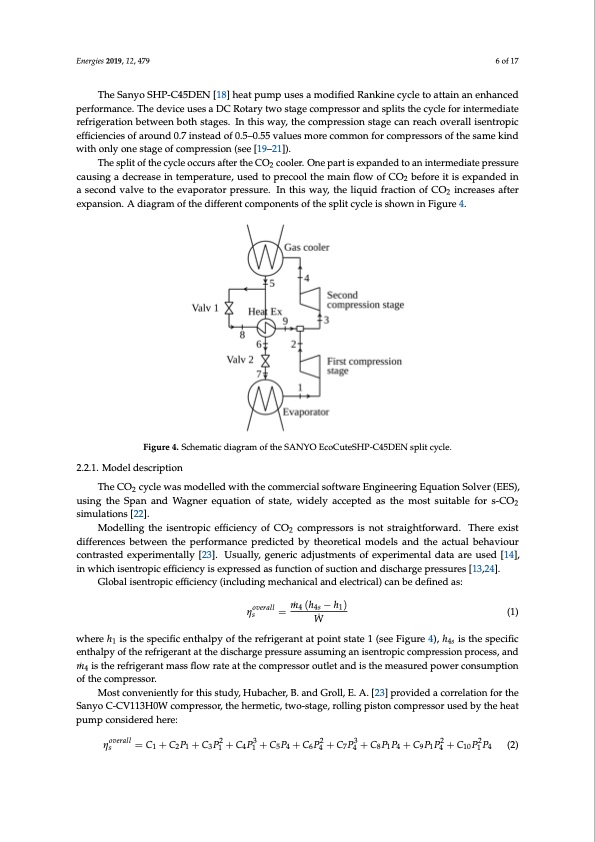
PDF Publication Title:
Text from PDF Page: 006
Energies 2019, 12, 479 6 of 17 The Sanyo SHP-C45DEN [18] heat pump uses a modified Rankine cycle to attain an enhanced performance. The device uses a DC Rotary two stage compressor and splits the cycle for intermediate refrigeration between both stages. In this way, the compression stage can reach overall isentropic efficiencies of around 0.7 instead of 0.5–0.55 values more common for compressors of the same kind with only one stage of compression (see [19–21]). The split of the cycle occurs after the CO2 cooler. One part is expanded to an intermediate pressure causing a decrease in temperature, used to precool the main flow of CO2 before it is expanded in a second valve to the evaporator pressure. In this way, the liquid fraction of CO2 increases after expansion. A diagram of the different components of the split cycle is shown in Figure 4. Figure 4. Schematic diagram of the SANYO EcoCuteSHP-C45DEN split cycle. 2.2.1. Model description The CO2 cycle was modelled with the commercial software Engineering Equation Solver (EES), using the Span and Wagner equation of state, widely accepted as the most suitable for s-CO2 simulations [22]. Modelling the isentropic efficiency of CO2 compressors is not straightforward. There exist differences between the performance predicted by theoretical models and the actual behaviour contrasted experimentally [23]. Usually, generic adjustments of experimental data are used [14], in which isentropic efficiency is expressed as function of suction and discharge pressures [13,24]. Global isentropic efficiency (including mechanical and electrical) can be defined as: ηoverall = m ̇ 4 (h4s − h1) (1) s W ̇ where h1 is the specific enthalpy of the refrigerant at point state 1 (see Figure 4), h4s is the specific enthalpy of the refrigerant at the discharge pressure assuming an isentropic compression process, and m ̇ 4 is the refrigerant mass flow rate at the compressor outlet and is the measured power consumption of the compressor. Most conveniently for this study, Hubacher, B. and Groll, E. A. [23] provided a correlation for the Sanyo C-CV113H0W compressor, the hermetic, two-stage, rolling piston compressor used by the heat pump considered here: ηoverall=C+CP+CP2+CP3+CP+CP2+CP3+CPP+CPP2+C P2P (2) s 1 21 31 41 54 64 74 814 914 1014PDF Image | Comparison of Transcritical CO2 and Conventional Refrigerant Heat Pump

PDF Search Title:
Comparison of Transcritical CO2 and Conventional Refrigerant Heat PumpOriginal File Name Searched:
energies-12-00479.pdfDIY PDF Search: Google It | Yahoo | Bing
CO2 Organic Rankine Cycle Experimenter Platform The supercritical CO2 phase change system is both a heat pump and organic rankine cycle which can be used for those purposes and as a supercritical extractor for advanced subcritical and supercritical extraction technology. Uses include producing nanoparticles, precious metal CO2 extraction, lithium battery recycling, and other applications... More Info
Heat Pumps CO2 ORC Heat Pump System Platform More Info
| CONTACT TEL: 608-238-6001 Email: greg@infinityturbine.com | RSS | AMP |